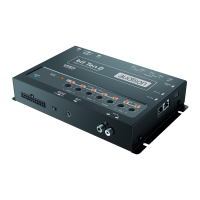29
23.
How to calibrate the Phone and Aux Ininput sensitivity.
Once the system is calibrated and fully working through the Front / Rear inputs, you can calibrate the PHONE
and AUX IN inputs.
- PHONE: To use this input you need to connect a phone hands-free kit (see 5.6).
Make a phone call, speak loudly and adjust the IN Level / PHONE knob until the LED flashes sporadically.
- AUX IN: To use this input you need to install the DRC (optional).
Through the DRC select AUX (see 10).
- If a source with a CD player is connected to the AUX input, disconnect the bit Ten D outputs from the
amplifiers and proceed as detailed in chapters 6.1.3 - 6.1.4.
- If the source to be connected to the AUX IN input has no CD player (e.g. mp3 player), you can calibrate
by listening.
A - Connect the bit Ten D RCA inputs (AUX IN) to the head unit output.
B - Play a music track.
C - Turn the IN Level / AUX knobs until the first distortion symptoms appear. Check if the IN Level / AUX LEDs
flash occasionally.
In this mode, even if the bit Ten D processor is connected to the PC, it does not interact with the software.
The OFFLINE mode
(see 8.1.3)
can be used to work on the software without connecting the bit Ten D to the PC to get
familiar with the multiple processor functions or to save settings that can be used later
(see 8.5.1)
.
The software is pre-set to start with a FRONT + REAR + SUB multi-amplified system.
To set a new “virtual” system, and so to change the inputs and select the outputs, you need to select the function I/O
Configuration Wizard in the Config window of the software main menu. Follow the same instructions as those for the
TARGET mode
(see 8.1.5)
.
Here is how the bit Ten D software appears when started in OFFLINE mode.
8.2 OFFLINE MODE
8

